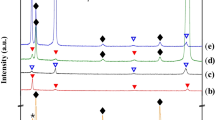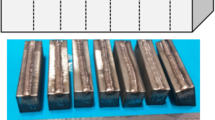Abstract
Flux-cored arc welding (FCAW) joints with 9% Ni steel were prepared using Ni-based superalloy filler metals. The correlation between the microstructure and mechanical properties of the weld joint based on the type of filler materials was investigated. Owing to the heat transferred during the welding process, the heat-affected zone (HAZ) of the base metal primarily comprised martensite and exhibited higher hardness than the weld metal and existing base metal. To evaluate the toughness of FCAW joints against low-temperature fractures, Charpy impact tests at −196 °C were conducted; an absorbed impact energy of at least 55 J was observed in the weld metal, HAZ, and base metal regions, which was significantly higher than the standard specification. Comparing Alloys 709 and 609 as filler metals, a higher absorbed impact energy was observed when using Alloy 709 in both the weld metal and HAZ regions. This is because the quantity of precipitates, which can act as a point of crack initiation and propagation in weld beads, was smaller when Alloy 709 was used, and the γ phase was stably maintained even at low temperatures owing to the high content of elements that decrease the martensite start temperature (γ stabilizers) in the bead and transition areas. Furthermore, Alloy 709 obtained a low volume fraction and small grain size in the coarse-grained HAZ, which is known as the toughness degradation zone. This can contribute to the higher impact toughness compared with Alloy 609.












Similar content being viewed by others
References
Mu W, Li Y, Cai Y, Wang M (2018) Cryogenic fracture toughness of 9%Ni steel flux cored arc welds. J Mater Process Technol 252:804–812. https://doi.org/10.1016/j.jmatprotec.2017.10.026
Mu W, Li Y, Cai Y, Wang M, Hua X (2019) The cryogenic low-cycle fatigue performance of 9% Ni steel joint made by flux cored arc welding. Mater Charact 151:27–37. https://doi.org/10.1016/j.matchar.2019.02.039
Li K, Wang X, Rui SS, Li X, Li S, Sun Q, Zhang Y, Cai Z (2022) Fatigue crack growth mechanism of Ni-based weld metal in a 9% Ni steel joint. Mater Sci Eng A 832:142485. https://doi.org/10.1016/j.msea.2021.142485
Xu T, Shi Y, Jiang Z, Wu L, Ma Y, Wang Z (2022) Improvement of cryogenic toughness for 9% Ni steel keyhole TIG butt-welded joints with a Ni interlayer. Mater Sci Eng A 835:142661. https://doi.org/10.1016/j.msea.2022.142661
El-Batahgy AM, Gumenyuk A, Gook S, Rethmeier M (2018) Comparison between GTA and laser beam welding of 9%Ni steel for critical cryogenic applications. J Mater Process Technol 261:193–201. https://doi.org/10.1016/j.jmatprotec.2018.05.023
Kim JW, Kim JS, Kang SW, Chun KS (2020) Laser welding of ASTM A553–1 (9% nickel steel) (part I: penetration shape by bead on plate). Metals 10:484. https://doi.org/10.3390/met10040484
Berejnoi C, Ipiña JEP (2016) Fracture toughness of ferritic steels in the ductile-to-brittle transition region. In: Alves LM, Ed. Fracture Mechanics - Properties, Patterns and Behaviours. IntechOpen, London. https://doi.org/10.5772/63410
DuPont JN, Lippold JC, Kiser SD (2009) Welding metallurgy and weldability of nickel‐base alloys. 9% Ni steel, 1st edn. John Wiley & Sons, Inc., New Jersey, pp 357
Fernandes VS, Farias FWC, Filho JCP (2020) Fracture toughness of a 9% Ni steel pipe girth welded with Ni-based superalloy 625 filler metal operating in a sour environment. J Mater Res Technol 9:6305–6321. https://doi.org/10.1016/j.jmrt.2020.03.044
Hwang JY, Choi KS, Jung HY (2022) Microstructural evolution and mechanical properties of FCAW joints in 9% Ni steel prepared with two types of Ni-based weld metals. Int J Adv Manuf Technol 120:6735–6746. https://doi.org/10.1007/s00170-022-09173-5
Kim NK, Kang YJ, Bang JH, Song SW, Seo SM, Kang CY, Kang NH (2021) Microstructural evolution and creep behavior of the weld interface between 10% Cr steel and Haynes 282 filler metal. Metals 11:764. https://doi.org/10.3390/met11050764
Mu W, Cai Y, Wang M, Hua X (2020) Microstructure characteristics and properties of fusion boundary in 9%Ni steel joint filled with Ni-based alloy. Mater Charact 165:110390. https://doi.org/10.1016/j.matchar.2020.110390
Passos AV, Farias FWC, Oliveira VHPM, Rios MCG, Filho JCP (2021) Sulfide stress cracking susceptibility of the heat-affected zone of an 9% Ni steel welded joint. Constr Build Mater 282:122573. https://doi.org/10.1016/j.conbuildmat.2021.122573
Oliveira JP, Shamsolhodaei A, Shen J, Lopes JG, Gonçalves RM, Ferraz MDB, Piçarra L, Zeng Z, Schell N, Zhou N, Kim HS (2022) Improving the ductility in laser welded joints of CoCrFeMnNi high entropy alloy to 316 stainless steel. Mater Des 219:110717. https://doi.org/10.1016/j.matdes.2022.110717
Jin Y, Jiahao S, Chenkai G, Yixuan Z, Hongbing L, Oliveira JP, Caiwang T, Zhishui Y (2021) Effect of heat input on interfacial microstructure, tensile and bending properties of dissimilar Al/steel lap joints by laser Welding-brazing. Opt Laser Technol 142:107218. https://doi.org/10.1016/j.optlastec.2021.107218
Oliveira JP, Shen J, Escobar JD, Salvador CAF, Schell N, Zhou N, Benafan O (2021) Laser welding of H-phase strengthened Ni-rich NiTi-20Zr high temperature shape memory alloy. Mater Des 202:109533. https://doi.org/10.1016/j.matdes.2021.109533
Martin AC, Oliveira JP, Fink C (2020) Elemental effects on weld cracking susceptibility in AlxCoCrCuyFeNi high-entropy alloy. Metall Mater Trans A 51:778–787. https://doi.org/10.1007/s11661-019-05564-8
Jenney CL, O’Brien A (2001) Welding handbook welding science & technology. American Welding Society, Miami, Florida
Kim BE, Park JY, Lee JS, Lee JI, Kim MH (2020) Effects of the welding process and consumables on the fracture behavior of 9 wt.% nickel steel. Exp Tech 44:175–186. https://doi.org/10.1007/s40799-019-00321-3
Akbari M, Kovacevic R (2019) Closed loop control of melt pool width in robotized laser powder–directed energy deposition process. Int J Adv Manuf 104:2887–2898. https://doi.org/10.1007/s00170-019-04195-y
Kou S (2003) Welding metallurgy. John Wiley & Sons, New York
Farias FWC, Filho JCP, de Azevedo LMB (2018) Microstructural and mechanical characterization of the transition zone of 9% Ni steel cladded with Ni-based superalloy 625 by GTAW-HW. Metals 8:1007. https://doi.org/10.3390/met8121007
Zhu Z, Ma X, Jiang P, Mi G, Wang C (2021) Planar-cellular-dendritic transformation in the fusion zone of a GH909 superalloy weldment. J Mater Res Technol 10:960–975. https://doi.org/10.1016/j.jmrt.2020.12.033
Brito C, Nguyen-Thi H, Mangelinck-Noël N, Cheung N, Spinelli JE, Garcia A (2019) Cellular-to-dendritic and dendritic-to-cellular morphological transitions in a ternary Al-Mg-Si alloy. Mater Sci Eng 529:012018. https://doi.org/10.1088/1757-899X/529/1/012018
Dong Y, Shuai S, Zheng T, Cao J, Chen C, Wang J, Ren Z (2020) In-situ observation of solid-liquid interface transition during directional solidification of Al-Zn alloy via X-ray imaging. J Mater Sci Technol 39:113–123. https://doi.org/10.1016/j.jmst.2019.06.026
Perricone MJ, Dupont JN, Cieslak MJ (2003) Solidification of Hastelloy alloys: an alternative interpretation. Metall Mater Trans A 35:1127–1132. https://doi.org/10.1007/s11661-003-0132-y
Cieslak MJ, Headley TJ, Romig AD (1986) The welding metallurgy of Hastelloy alloys C-4, C-22, and C-276. Metall Mater Trans A 17:2035–2047. https://doi.org/10.1007/BF02645001
Dupont JN, Lippold JC, Kiser SD (2009) Welding metallurgy and weldability of nickel-base alloys. John Wiley & Sons, New Jersey
Turchi PEA, Kaufman L, Liu ZK (2006) Modeling of Ni–Cra–Mo based alloys: part I—phase stability. Calphad 30:70–87. https://doi.org/10.1016/j.calphad.2005.10.003
Qiu Z, Wu B, Zhu H, Wang Z, Hellier A, Ma Y, Li H, Muransky O, Wexlera D (2020) Microstructure and mechanical properties of wire arc additively manufactured Hastelloy C276 alloy. Mater Des 195:109007. https://doi.org/10.1016/j.matdes.2020.109007
Mu W, Cai Y, Wang M (2021) Effect of precipitates on the cryogenic fracture toughness of 9%Ni steel flux cored arc weld. Mater Sci Eng A 819:141418. https://doi.org/10.1016/j.msea.2021.141418
Chen ZR, Lu YH (2015) TEM observation of martensite layer at the weld interface of an A508III to Inconel 82 dissimilar metal weld joint. Mater Sci Eng A 46:5494–5498. https://doi.org/10.1007/s11661-015-3171-2
DuPont JN, Kusko CS (2007) Martensite formation in austenitic/ferritic dissimilar alloy welds. Weld J 86:51s–54s. http://files.aws.org/wj/supplement/wj0207-51.pdf. Accessed 24 Aug 2022
Wang Z, Xu B, Ye C (1993) Study of the martensite structure at the weld interface and the fracture toughness of dissimilar metal joints. Weld J Res Suppl 72:397–402. https://files.aws.org/wj/supplement/WJ_1993_08_s397.pdf. Accessed 24 Aug 2002
Mas F, Tassin C, Roch F, Yescas M, Todeschini P, Bréchet Y (2018) Growth morphologies and primary solidification modes in a dissimilar weld between a low-alloy steel and an austenitic stainless steel. Metals 8:284. https://doi.org/10.3390/met8040284
Hart GLW, Mueller T, Toher C, Curtarolo S (2021) Machine learning for alloys. Nat Rev Mater 6:730–755. https://doi.org/10.1038/s41578-021-00340-w
Jang JI, Ju JB, Lee BW, Kwon DG, Kim WS (2001) Micromechanism of local brittle zone phenomenon in weld heat-affected zones of advanced 9% Ni steel. J Mater Sci Lett 20:2149–2152. https://doi.org/10.1023/A:1013784600394
Yan C, Wu L, Wu W, Yuan Y, Yang X (2019) Prediction of HAZ width in submerged arc welding of mild steel. IOP Conf Ser Earth Environ Sci 252:022078. https://doi.org/10.1088/1755-1315/252/2/022078
Kim JW, Kim JS (2020) Laser welding of ASTM A553–1 (9% nickel steel) (part II: comparison of mechanical properties with FCAW). Metals 10:999. https://doi.org/10.3390/met10080999
Huang G, Wan X, Wu K, Zhao H, Misra RDK (2018) Effects of small Ni addition on the microstructure and toughness of coarse-grained heat-affected zone of high-strength low-alloy steel. Metals 8:718. https://doi.org/10.3390/met8090718.Accessed24August2022
Saitoh N, Yamaba R, Muraoka H, Saeki O (1993) Development of heavy 9% nickel steel plates with superior low-temperature toughness for LNG storage tanks. Nippon Steel Tech Rep 9–16. https://www.nipponsteel.com/en/tech/report/nsc/pdf/5802.pdf. Accessed 24 Aug 2022
Price AH (2013) Significant system parameters influencing HAZ properties in 9%Ni steel. Sci Technol Weld join 6:255–260. https://doi.org/10.1179/136217101101538758
Park JH, Kim YH, Baek HJ, Cho SM (2019) A study on process development of super-TIG welding for 9% nickel steel with Alloy 625. J Manuf Process 40:140–148. https://doi.org/10.1016/j.jmapro.2019.03.017
Filho JCP, Passos EKD, Gonzaga RS, Santos DD, Maia VP, Juliano DR (2020) The influence of the welding process on the ultrasonic inspection of 9%Ni steel pipe circumferential welded joints. Materials 13:961. https://doi.org/10.3390/ma13040961
Wang H, He G (2016) Influence of flux composition on the performance of a nickel-based alloy covered electrode for 9% Ni steel welding. Weld J 95:467–478. https://s3.amazonaws.com/WJ-www.aws.org/supplement/WJ_2016_12_s467.pdf. Accessed 24 Aug 2022
Funding
This study has been conducted with the support of the Korea Institute of Industrial Technology as research project “PEH22130 [key-tech] localization of 3D printed national defense parts and demonstration support technology development (1/5).”
Author information
Authors and Affiliations
Contributions
Ji Yong Hwang: data analysis, investigation, writing–original draft and revision. Kwangsu Choi: data collection and analysis. Hyo Yun Jung: supervision, review and editing.
Corresponding author
Ethics declarations
Ethics approval
Not applicable.
Consent to participate
The submission of the article has been approved by all co-authors.
Consent for publication
The publication has been approved by all co-authors.
Conflict of interest
The authors declare competing interests.
Additional information
Publisher's Note
Springer Nature remains neutral with regard to jurisdictional claims in published maps and institutional affiliations.
Rights and permissions
Springer Nature or its licensor holds exclusive rights to this article under a publishing agreement with the author(s) or other rightsholder(s); author self-archiving of the accepted manuscript version of this article is solely governed by the terms of such publishing agreement and applicable law.
About this article
Cite this article
Hwang, J.Y., Choi, K. & Jung, H.Y. Correlation between microstructure and mechanical properties of welding joint in 9% Ni steel with two types of Ni-based superalloy filler metals. Int J Adv Manuf Technol 122, 2761–2773 (2022). https://doi.org/10.1007/s00170-022-10069-7
Received:
Accepted:
Published:
Issue Date:
DOI: https://doi.org/10.1007/s00170-022-10069-7




